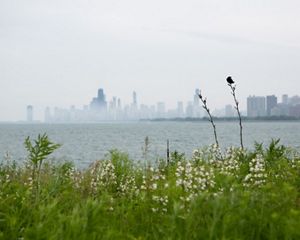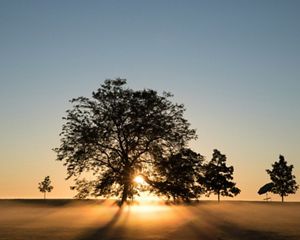A Conversation About Race and the Environmental Movement
Q&A with Urban Ecologist Mila K. Marshall
Over Memorial Day weekend in 2020, a racist incident in New York’s Central Park, followed by the violent murder of George Floyd, highlighted all-too-frequent events that make Black birders, naturalists and outdoor enthusiasts feel unwelcome and unsafe in public space. Former State Director Michelle Carr sat down in June of 2020 with Mila K. Marshall, an urban ecologist and doctoral candidate studying Ecology and Evolutionary Biology at the University of Illinois at Chicago, for a conversation about race, the outdoors and why environmentalists cannot remain silent in the face of racial violence and inequity.
Michelle:
Birding is often thought of as an introduction or gateway into other environmental spaces and efforts. Right now, we see focus on the experiences of Black birders, but how can the momentum and dialogue from this moment be harnessed to address pressing environmental issues faced by communities of color?
Mila:
One thing I love about the recent media coverage of #BlackBirdersWeek is the fact that there is so much visualization of Black people holding research and scientific positions in countries across the world. This is a truth that isn’t always portrayed in the media and on TV. The interviews and articles we’ve seen and read lately, however, convey the fact that we are active in these fields and we get paid to do this type of work. This representation is really important when you think about diversity and where we are in the environmental sector. How many people of color are serving on boards and in leadership roles in conservation? We need to grow these numbers, and so these are some of the lines of questioning we need to explore.
I also hope this moment is an opportunity to turn our attention to other issues and the ties between conservation and environmental justice. I’ll give you an example: right now we have serious water quality issues that impact both people and nature. But just because you own a boat doesn’t mean you necessarily care about clean water, and these issues still aren’t making headlines. All of us rely on and enjoy the natural world, but not everyone understands how to advocate for it. And it’s not just something to address on a personal level; there are so many professionals who depend on water to do their jobs: plumbers, landscape architects and designers, and more. How do we get those professionals and other stakeholders and decision-makers more involved in issues that affect all of us?
Michelle:
That’s one thing that the COVID-19 pandemic has brought into stark relief: how environmental issues—poor air quality, lack of clean water—have a direct impact on human health. Environmental justice leaders have long worked to reduce environmental, health, economic and racial disparities. How can green NGOs work to more effectively protect the health of both nature and people?
Mila:
Green NGOs have reach, and what we need to do is learn how we partner strategically. I think for many in the environmental world, when people show up in nature, focusing on their needs may seem like mission creep. I urge you to think creatively about your network and who you can introduce them to. Ask yourself this: if you can’t meet a particular need, how can you engage ethically? How can you acknowledge the resources that you have, and how can you make introductions to organizations that can meet those needs? This work is an investment in the community.
And as we talked about earlier, as green NGOs also look to work with people of color on their staff, boards and leadership teams, I would ask you to look at the barriers within your own organization and ask: are you ready to take them down? For example: look at the requirements for open positions in terms of hours, certifications and education. Are there ways to negotiate these requirements? Could you hire someone part-time and allocate hours for them to earn that naturalist certification that your organization requires? Can you look at this person you are hiring as an investment?
Quote: Mila K. Marshall

As environmentalists, we have to talk about how segregation impacts the things we want to get done. We do need to understand how living in a segregated system plays out in the landscape.
Michelle:
Systemic racism affects every facet of our society, but we don’t often talk about how it affects nature. How do you see it impacting the natural world?
Mila:
As environmentalists, we have to talk about how segregation impacts the things we want to get done. We do need to understand how living in a segregated system plays out in the landscape. Communities of color are facing a lack of access to clean air, clean water and healthy food. That means the time and resources go to addressing those immediate issues, and we may not see investments in parks, natural areas and other resources. As a result, you may see the tree canopy change, and then a shift in migratory bird populations. It’s not that communities of color don’t want to make these investments in nature, it’s that they have to focus on their immediate needs. And if you’re living in a different part of the city, where you don’t have to worry about the quality of the air you breathe and the water you drink, this may not even occur to you.
That’s another aspect of the work that needs to be done. We have to ask: “Where do we get to see each other? How have we created a system in which we are so separate, that we have to reach out to learn that Black people bird? We all live in the same system, so how does it occur that we don’t know each other?” Segregation perpetuates stereotypes. Separateness creates the illusion of separateness. It leads us to a situation where people don’t realize that Black people go birding and enjoy nature. And that means we are also missing opportunity to build alliances because of the segregation that exists.
We have to do the work to remedy this. It’s not going to fix itself. It’s going to take time, resources and listening.
Michelle:
Within communities of color, environmental scholars and leaders are researching and addressing many of these issues. How do we amplify their work and facilitate increased collaboration, especially as we face the threat of climate change—arguably the biggest environmental challenge of all time?
Mila:
When research papers are published on urban conservation, ecosystem services, environmental justice and other issues here in Chicago and across the country, there have been many missed opportunities to bring in the research and voices of Black ecologists, biologists and scientists. These experts bring a breadth and depth of knowledge and experience that are unique. We need more collaborations with grass roots experts and to provide these environmental leaders with an opportunity to author.
It's also important to honor and recognize those who do environmental justice work, even if they don’t work for a nature organization. We have to lift up the voices of the people who have lived this history, the Black leaders. It is imperative that we know the history of people who have dedicated their careers to equity in the outdoors.
Quote: Mila K. Marshall

We’re inviting Black and brown people to the table for the perspective that they bring, not just because they are Black and brown… How are we ready to adapt? How are we going to change once we have those perspectives?
Michelle:
For a long time, many conservation efforts have been premised on a false dichotomy between people and nature. How do we bring more stakeholders into a holistic conversation and approach to protecting both?
Mila:
We need to have diverse perspectives and we need to diversify the narratives. We’re inviting Black and brown people to the table for the perspective that they bring, not just because they are Black and brown. And when we do that, we have to ask: How are we ready to adapt? How are we going to change once we have those perspectives?


